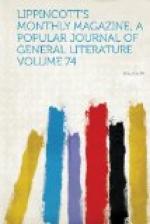But to return to the Sacro Collegio. In one of the immense labyrinthine cellars is a botte for wine capable of containing five thousand litri. There, it is said—I know not how truly—once a year, when the botte was emptied, came four of the spiritual fathers of the college above, with a table and chairs, and played a certain game of cards, which was one of their simple amusements. Whether this meeting was intended as an exorcism of any evil influences which might threaten the new must about to be put in, or a mild bacchanalian tribute to the empty space from which they had drawn so much comfort and cheerfulness during the year, or whether the wine left some fine perfume behind it which they wished to inhale, tradition saith not. Maybe the fathers never went there, and the story is merely ben trovato.
In the school of design we admired a copy of some of the carving of the choir of the cathedral of Asisi. The leaves were remarkably crisp and all the lines full of life. My guide told me that this choir and the famous one of St. Peter’s in Perugia were designed by the same artist, but that of Perugia was executed by another and more timid hand, while this of Asisi was carved by the artist himself.
Our last visit in the college was to the grand loggia—finer than anything of the kind I have seen in Italy except the Loggia del Paradiso of Monte Casino, which is open, while this of San Francesco is closed. The grandeur of this loggia, with its lofty arches and long perspective, is in harmony with the magnificence of the view to be seen from it. Seated there, on the stone divan that runs the whole length of the colonnade, I listened a while to the very interesting talk of my companion. This gentleman, Professor Cristofani, is said to be one of the most learned men in Umbria, and has studied so thoroughly his native province as to be an authority on all that concerns its history and antiquities. A native of Asisi, he has devoted himself especially to that city, and his Storia di Asisi and Guida di Asisi are monuments of learned and patient research. He has written also a history of San Damiano which has lately been translated in England.
The government took possession of this church and convent of San Damiano, the first home of St. Clara and her companions, and proposed establishing there a school of arts and trades; but Lord Ripon persuaded them to sell the property to him, and in his turn presented it to the frati from whom it had been taken. It is a rough place, but interesting in memories.
“I have a book in petto,” the professor said, “which will, I think, be more valuable and interesting than the others. I have collected material for a history of the church and convent of St. Francis, and shall write it as soon as I have time. I should be glad if it could be illustrated.”




